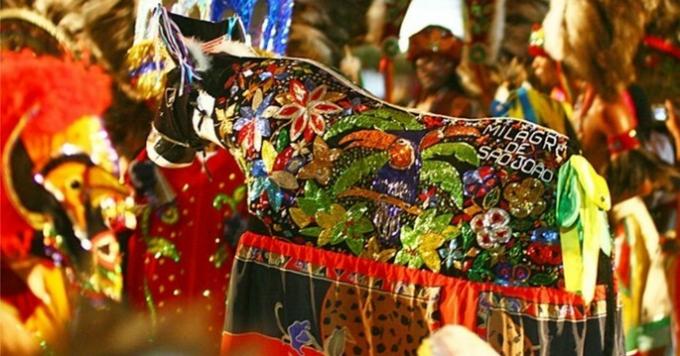Popular culture represents a set of knowledge determined by the interaction of individuals. It brings together cultural elements and traditions that are associated with popular and oral language.
Thus, popular culture includes folklore, crafts, music, dances, parties, among others.
Folklore, used as a synonym for popular culture, is composed of a set of legends and myths transmitted between generations and represents the cultural and social heritage of a people.
It is worth noting that the term culture is very broad and brings together behaviors, symbols and social practices. It is, therefore, a set of factors that make up a society, such as the knowledge, beliefs, customs and traditions of a given people.
Literature, music, theater, dance, cuisine, religion, etc. stand out.
Brazilian popular culture

Brazilian popular culture brings together a set of legends, myths and traditions of the country, which are based on in the history and miscegenation of cultures, of which the following stand out: the Portuguese, the African and the indigenous.
Discover examples of popular culture that stand out in each area.
| Brazilian popular literature | |
|---|---|
| Literature of twine | Traditional literary cultural manifestation, especially in the northeastern interior. It is characterized by small books with woodcut covers, hanging on string or rope. |
| riddles | Questions that start with "What is it, what is it???" and that usually have funny answers. |
| Proverbs and Sayings | Short sentences whose main social purpose is to advise and warn. |
| Parlendas | Children's rhymes that entertain and work on memorizing and fixing some concepts. |
| Brazilian folklore legends | A set of stories and tales narrated by the people and transmitted from generation to generation. |
| Legends of the Southeast | Main legends of the Southeast region of Brazil, such as the legend of Curupira and the legend of the headless mule. |
| Legends of the North Region | Main legends of the North Region, such as the legend of Boto and the legend of Vitória-régia. |
| Legends of the Southern Region | Main legends of the South Region, such as the legend of Negrinho do Pastoreio and the legend of Saci-pererê. |
| Legends of the Northeast Region | Main legends of the Northeast Region, such as, for example, the legend of the Red Beard and the legend of the Papa-fig. |
| Legends of the Midwest Region | Main legends of the Midwest region, such as the legend of Mãe-do-ouro and the legend of Nego d'água. |

| Popular Brazilian Music | |
|---|---|
| folk songs | Folk and traditional songs that are part of popular wisdom. |
| circle songs | Folk songs sung on a wheel. |
| lullabies | Songs sung to make children and babies sleep. |
| Samba | Dance and musical genre, considered one of the most representative elements of Brazilian popular culture. |
| country music | One of the most popular musical styles in Brazil, where the original guitar sound predominated. |
| viola fashion | One of the main types of Brazilian country music, composed of guitar solos and narrative speeches. |
| Bossa nova | Type of Brazilian popular music that has a strong influence from Rio de Janeiro samba and North American jazz. |
| MPB - Brazilian popular music | Brazilian musical genre that has a strong influence of Brazilian folklore, especially with regard to indigenous, African and European cultures. |

| Brazilian folk dances | |
|---|---|
folk dances |
Traditional dances characteristic of each Brazilian state, sometimes derived from religious rituals. |
| Frevo | Traditional folk dance in northeastern Brazil, especially in Recife and Olinda. |
| Gang | Traditional rustic dance from June festivals. |
| Maracatu | Traditional dance from the state of Pernambuco, which mixes African, Portuguese and indigenous cultures. |
| Stamp | Traditional dance from the state of Pará, which is marked by rotating movements. |

| Popular partiesbrazilian | |
|---|---|
| Carnival | Party that takes place three days before Ash Wednesday, where, in some states, masquerade balls, costume parades and/or electric trios are common. |
| June parties | Popular festivals that take place in June, where square dances and typical foods are common, such as hominy, rice pudding and corn cake. |
| revelry of kings | Cultural festival of a religious character, whose objective is to commemorate the visit of the Three Magi. |
| Nazare's Cirio | Religious festival celebrated in October, in Belém do Pará, in devotion to Our Lady of Nazaré. |
| Feast of the Divine | Religious festival celebrated in the month of May in different parts of Brazil, to adore the Holy Spirit. |
| Boom my ox | Also called Boi-bumbá, it consists of a dance typical of the North and Northeast, where there is a theatrical presentation in which the ox is the main character. |

popular culture and high culture
The term “popular” is in opposition to the term “scholar”. At popular culture, traditions are carried out by the people, who participate in an organic and active way, and are therefore formed spontaneously.
already the high culture, considered “superior”, is elected as the most “cultured”. In other words, it is produced and appreciated by individuals who have greater purchasing power (elite) and, therefore, it is more restricted.
High culture, unlike popular culture (which is formed by the coexistence of people), is elite and demands studies.
It is associated with museums, libraries, theaters, cultural centers, classical music and classical music performances, such as operas.
We must remember that no culture is superior to another. Each one carries its cultural and social heritages, which develop according to various factors involving the cultural diversity.
popular culture and mass culture
THE mass culture, also called "pop culture" corresponds to that carried out by the cultural industry and broadcast in the mass media.
Both are associated with contemporary industrialized society, that is, with capitalist industrial production.
In this sense, art and culture are produced in an “artificial” way to attract the masses, and with the main purpose of generating profit.
Thus, in mass culture, cultural and artistic products are commodified, unlike the that happens in popular culture, that arises from the interaction of the people and is not imposed by the industry cultural.
folklore quiz
Don't stop here! O All Matter selected a series of neat texts to help you broaden your knowledge.
- Source of popular expressions you need to know
- Culture: concept, characteristics, elements and types
- questions about culture



